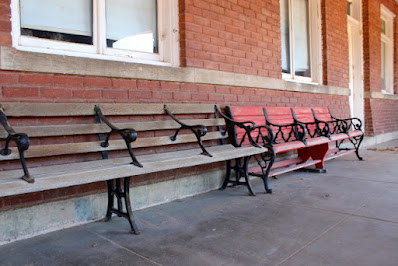Located in downtown Alva (population 4,95) are a number of nice murals painted on buildings. Also located in Alva is the Cherokee Strip Museum that is housed in the old hospital facility.
The Museum contains pioneer artifacts and historical items, along with information about a WW II Prisoner of War (POW) Camp that was located south of town. Although the museum complex was closed when I stopped, there were a number of outdoor exhibits featuring equipment used by early settlers.
Waynoka (population 915) was historically a major stop on the early rail lines with 50-to-100 trains per day passing through town. Waynoka was such an important rail center that it was one of the stops for the San Francisco Chief.
To accommodate travelers, a Harvey House was built as an extension of the train depot and is now part of the Waynoka Depot Museum. Other outdoor exhibits that are part of the museum include a diesel locomotive, historic log cabin, Section Foreman's House, and other railroad related items.
Boiling Springs received its name because water from numerous underground springs rose rapidly to the surface, creating a "boiling effect." Spanish explorers from Mexico first visited the springs in 1541; then in the early 1800s Nathan Boone, son of Daniel Boone, explored the springs area while on a scouting expedition from Fort Gibson in eastern Oklahoma. The springs are now part of the Oklahoma State Park system, but they do not "boil" like they did historically.
Woodward (population 11,975) is located along the historic Great Western Cattle Trail and is the largest city in a nine-county area. In the late 1800s, Woodward was one of the most important southwest stations for shipping cattle to Eastern United States.
When I stopped in Woodward I visited with an old cowboy that was leaning against a fence next to an outdoor display and he told me that in the "ol' days" cowboys rode various species of dinosaurs while rounding up the cattle. He said that the T-Rexs were trained to eat tofu, and not the cattle.
I just happened to be passing through Shattuck (population 1,350) while they were having the 32nd Annual International Windmill Trade Fair Festival. Everyone I met was really friendly and they invited me to come downtown and participate in the various activities. Apparently, at the fair there were exhibits, seminars on how to build your own windmill, and trading booths where you could find windmill parts. Unfortunately, I only had time to visit the Windmill Museum and had to pass on gong to the fair.
The original first windmill was designed and patented by Daniel Halladay. It was exhibited at the 1854 New York State Fair and was awarded a prize as "The most valuable newly invented machine for farmers." Without windmills, it would not have been possible to settle most of western united states.
When I toured the museum facility, there were 63 windmills on display and all of the windmills were reported to have been used at one time for pumping water. No two windmills in the museum were alike and they ranged in size from the 5-ft "Star Zephyr" to the large 18-ft "Samson." Also located on the site was an early pioneer home, general store, half-dugout "Soddy," historic well-drilling rig, and a barn full of windmill equipment and parts.
Fort Supply (1868-1895) was a U.S. Army Post in Indian Territory that was built to support General Philip Sheridan's campaign against the Southern Plains Indians. It was from this location that George Armstrong Custer left when he led the Seventh US Cavalry south to the camp of Chief Black Kettle in the Battle of the Washita. Ironically, the Fort was later used to protect the Cheyenne and Arapaho Reservations from incursions by settlers. The last mission at the Fort before it closed was to bring an end to the Enid-Pond Creek Railroad War during the summer of 1894.
In the 1880s the Rock Island Railroad built rail lines into Indian Territory and established towns near some of the existing stage stations - one near Enid and one near Pond. Then, prior to the 1893 Oklahoma Land Run, the U.S. Department of the Interior divided the Indian Territory acquired lands into counties and conspired with various individuals to speculate on town sites that were different than the existing railroad town sites. The government used the same names for the new towns, so there was a railroad Pond Creek and a government Pond Creek, and a railroad Enid and a government Enid. The railroad refused to stop trains at the government towns, so the government notified the railroad that they had to furnish mail service to the government towns. In response, the railroad hung mail from a pole by the tracks and used a hook to grab the mail without slowing the train. The government town tried posting speed limits through towns, but the train engineers ignored the speed limits. When speed limits did not work, the towns started placing wagons and other debris on the tracks and in some places actually tearing up the tracks. Troops from Fort Supply were sent in to restore order and then in 1894 President Grover Cleveland signed Act 28 Stat. 263 requiring railroads "to establish and maintain passenger stations and freight depots at or within one-fourth of a mile of the boundary limits of all town sites...in said Territories." This Act ended the Enid-Pond Creek Railroad War.
I stopped by the Fort Supply Historic Site for some pictures and the security officer told me that the existing Fort is a reproduction that is primarily used for celebrations and other special events.







































No comments:
Post a Comment